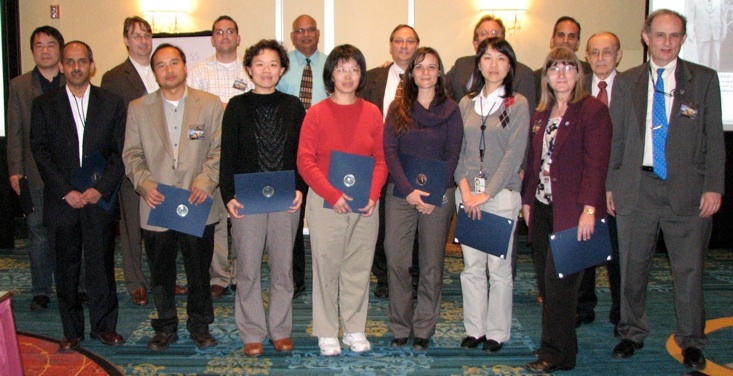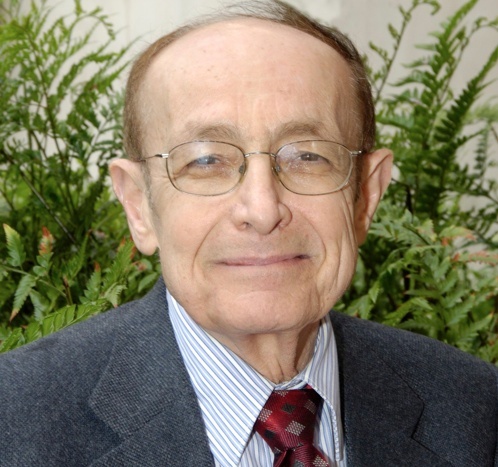News | December 7, 2010
NOAA AIRS Team Members Honored with NASA Group Achievement Award

NOAA AIRS Team Members, front row, left to right: M.K. Rama Varma Raja, Xiaozhen (Shawn) Xiong, Jennifer Wei, Fengying Sun, Antonia Gambacorta, Zhaohui Zhao, Mary Kicza, Jack Kaye. Second row, left to right: Haibing Sun, Nicholas Nalli, Eric Maddy, Murty Divakarla, Chris Barnet, Mitch Goldberg, AIRS Project Manager Tom Pagano (JPL), AIRS Science Team Leader Moustafa Chahine (JPL).
For outstanding contributions in improving weather forecasting using data from the Atmospheric Infrared Sounder and production of its key climate data products
By Tom Pagano and Sharon Ray, Jet Propulsion Laboratory
The National Oceanic and Atmospheric Administration, NOAA, has been a major contributor to the success of the AIRS Project, and to honor that effort NOAA AIRS team members were recently recognized for their valuable contributions in a ceremony at the NASA Sounding Science Team Meeting in Greenbelt, Maryland last November.
NOAA team members were recognized for running the JPL-developed AIRS Team algorithms on their operational production system and distributing the data to National Weather Prediction (NWP) centers worldwide. They also support algorithm development of the AIRS geophysical products including temperature and water vapor and trace gases, and finally they've helped validate the AIRS data products with their extensive database of in-situ observations including radiosondes, towers, ship-based, aircraft and flask measurements. In addition, NOAA staff have authored over 28 peer reviewed publications since launch of AIRS contributing greatly to the body of scientific knowledge gained from this instrument.
And the accomplishments don't end there. Within one year after launch, NOAA's Center for Satellite Applications and Research (STAR) organization successfully loaded the AIRS Level 1B algorithm into their operational production and distribution system and was sending AIRS data to NWP centers worldwide within 3 hours of acquisition. Within three years after launch, the National Centers for Environmental Prediction (NCEP) achieved significant positive impact (5 hours on the 6 day forecast) by assimilating AIRS data into the operational forecasting system. Their continued effort has shown that additional forecast improvement is possible by assimilation of AIRS cloud cleared radiances and water vapor channels.[[IMAGE||/system/internal_resources/details/original/67_shapeimage_2.png||Left||348||shapeimage_2||AIRS NOAA team members Eric Maddy and Nick Nalli||||247||]]
[[IMAGE||/system/internal_resources/details/original/68_shapeimage_1_1.png||Right||336||shapeimage_1_1||Chris Barnet of NOAA/NESDIS/STAR shakes the hand of fellow award recipients.||||241||]]NOAA/STAR was extremely influential in development of the AIRS geophysical products by providing regression coefficients for the retrieval initialization, algorithms for cloud clearing and development of the AIRS carbon Monoxide and methane Products.
NOAA routinely validates the AIRS data with in-situ observations as mentioned above, and communicates the value of AIRS carbon monoxide, ozone, carbon dioxide and methane products to their operational users. NOAA uses AIRS data to generate an aviation alert for emissions of sulfur dioxide from volcanoes. Their participation with the science community has lead to the direct observation of stratospheric-tropospheric exchange of ozone using AIRS data and the direct observation of emissions of methane from Asia. NOAA routinely uses AIRS Data to calibrate the GOES instruments, and cross-compare with instruments on US and International platforms.
The NOAA AIRS Team's performance has been outstanding because they have not only provided the global user community with the data in an extremely timely fashion (near real-time), they have gone the next step and shown them both how to use it and how accurate it is. NOAA has taken ownership of the AIRS products and continually provides improvements that have contributed greatly to the quality of the AIRS products today. They have contributed with minimal investment from NASA and have brought their own support to the project in many areas.
NOAA has brought their innovative ideas and experience over several decades of atmospheric sounding to the project. We believe that the relationship between AIRS and NOAA has been one of the most successful in the Earth Science community and will continue to flourish as we transition to future infrared sounders.
[[IMAGE||/system/internal_resources/details/original/69_IMG_4909-leveled.jpg||Left||733||IMG_4909-leveled||Left to right: NOAA/NESDIS/STAR's Chris Barnet and Mitch Goldberg, AIRS Science Team Leader Moustafa Chahine, NOAA Assistant Administrator for Satellite and Information Services Mary Kicza, Associate Director for Research of the Earth Science Division within NASA's Science Mission Directorate Jack Kaye, AIRS Project Manager Tom Pagano.||||504||]]





